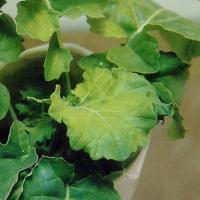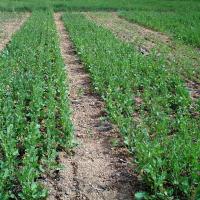Symptoms below are only a guide and should be verified by plant nutrient test
Diagnosing zinc deficiency in canola
Although canola is moderately susceptible to zinc deficiency, it is rarely seen in the paddock because many fertilisers have trace zinc levels, canola appears to be more effective in using soil zinc, and mild deficiency is difficult to identify.
What to look for
- Stunted pale plants with areas of poorer growth alongside healthy, apparently normal plants giving the crop a patchy appearance.
- Worse symptoms are expected on sandy or alkaline grey clay soils, particularly if newly limed, and better on old windrows . Plants often improve on windrows.
Paddock
- Stunted pale plants with areas of poorer growth alongside healthy, apparently normal plants giving the crop a patchy appearance.
- Worse symptoms are expected on sandy or alkaline grey clay soils, particularly if newly limed, and better on old windrows . Plants often improve on windrows.
- Stunted plants with pale green young leaves, particularly between leaf veins.
- Leaf blades bend down.
- Shortened internodes as stems elongate.
Paddock
What else could it be
| Condition | Similarities | Differences |
|---|---|---|
| Diagnosing molybdenum deficiency in canola | Smaller plants with pale green leaves; interveinal chlorosis | Molybdenum deficiency also causes scattered dead leaf spots; healthy and deficient plants are often intermixed. Molybdenum deficient leaves have scorched edges. |
| Diagnosing copper deficiency in canola | Smaller plants with pale green leaves; interveinal chlorosis | Copper deficient plants have numerous yellow specks that develop between veins of older leaves. This progresses until the whole plant appears pale green. |
Where does it occur?

Dry conditions

Spraying herbicide

Soil ph
- Most sandy surfaced soils required copper and zinc when initially cleared for agriculture
- Zinc is relatively immobile in soil and becomes unavailable to crops in dry soil.
- Where soil levels are marginal, zinc deficiency can be induced by applications of lime, increased nitrogen fertiliser, and copper fertiliser
- The use of root-pruning herbicides can induce zinc deficiency
- Zinc deficiency is more common in high pH and clay soils
Management strategies

Soil application

Spraying foliar
- Foliar spray (effective only in current season) or drilled soil fertiliser
- Zinc foliar sprays need to be applied as soon as deficiency is detected to avoid irreversible damage
- As zinc is immobile in the soil topdressing is ineffective, only being available to the plant when the topsoil is wet
- Mixing zinc throughout the topsoil improves availability due to more uniform nutrient distribution.
- Zinc drilled deep increases the chances of roots being able to obtain enough molybdenum in dry seasons
- Zinc seed treatment is used to promote early growth where root disease is a problem, but the level is lower than a plant needs in the current season.
- Zinc present in compound fertilisers often meets the current requirements of the crop
How can it be monitored?

Soil test

Tissue test
- A DTPA zinc soil test provides at best a rough guide to soil zinc status
- Whole-top plant test provides a rough guide if paired good/ poor samples are taken, but this should be confirmed with a youngest emerged blade (YEB) test.
- Whole shoots of young plants [40 days] below about 23 mg/kg, and YEB levels below about 15 mg/kg indicate zinc deficiency
See also
Further information
Where to go for expert help
Page last updated: Wednesday, 6 May 2015 - 11:25am



